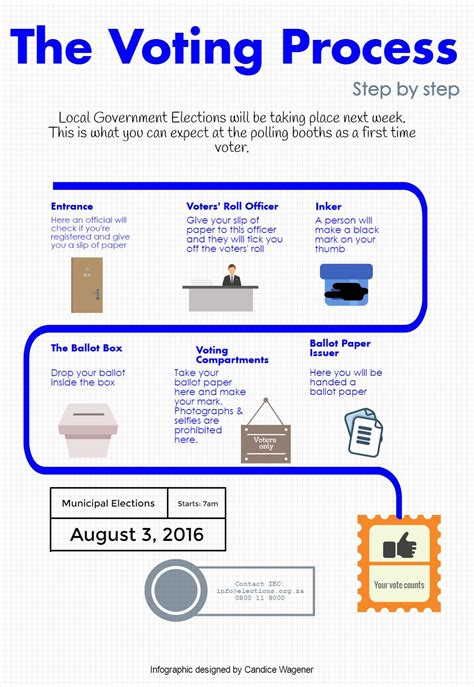Explore the essential steps in the voting process, from registration to casting ballots, understanding results, and the significance of voting in democracy.In a democracy, the power of the people is expressed through the act of voting, making it a cornerstone of civic engagement. The Voting Process In The U.S.: A Step-By-Step Guide offers an insightful exploration of this vital procedure, illuminating each phase from registration to the final tally. Whether you’re a first-time voter or a seasoned participant, understanding the intricacies of the voting process is essential for making informed decisions that drive our nation forward. This guide will take you through the essential steps, including how to register to vote, preparing for election day, and what happens after you cast your ballot. Discover the importance of your voice in shaping democracy and ensure your participation in this fundamental right.
Understanding The Importance Of The Voting In Democracy
The act of voting is not just a civic duty; it is a fundamental pillar of democracy. It allows citizens to express their opinions and influence the decision-making process that affects their lives and communities. Voting is essential because it provides individuals with the power to choose their leaders, shape policies, and advocate for the issues they care about most.
Here are some key reasons highlighting the importance of voting in a democratic society:
| Reason | Description |
|---|---|
| Empowerment | Voting empowers individuals by giving them a voice in government. It’s a way for citizens to express their preferences and priorities. |
| Representation | Through voting, citizens choose representatives who align with their values and interests, ensuring that various perspectives are considered in governance. |
| Civic Engagement | Voting encourages greater civic engagement and responsibility, fostering a sense of community and participation in the democratic process. |
| Accountability | When citizens participate in voting, they hold elected officials accountable for their actions and policies, making it more likely that leaders will act in the public’s best interest. |
The importance of voting cannot be overstated. It is a crucial mechanism that facilitates the functioning of democracy, ensuring that every member of society has a stake in the governance process. As such, participation in elections is imperative for a healthy and vibrant democracy.
Step 1: Registering To Vote In The Voting Process
One of the fundamental steps in The Voting process is registering to vote. This ensures that you are recognized as an eligible voter and that your voice can be heard in the elections. The registration process may vary from state to state, but there are several common steps involved.
First, it’s important to check your eligibility. Generally, you must be a U.S. citizen, a resident of the state where you intend to vote, and at least 18 years old by election day. Some states allow 17-year-olds to register if they will turn 18 by the time of the election.
Once you’ve confirmed your eligibility, you can proceed with the registration process. Here’s how:
- Visit your state’s election office website: Most states provide online registration, which is the most convenient method. If your state doesn’t allow online registration, you can download a form that you can fill out and mail to your local election office.
- Provide the necessary information: When registering, you will typically need to provide your name, address, date of birth, and sometimes your driver’s license number or Social Security number.
- Check registration deadlines: Each state has its own registration deadlines, which can be as much as 30 days prior to an election. Ensure that you register before the deadline to be eligible to vote.
- Confirm your registration: After submitting your registration, check your status on your state’s election website to ensure that everything is correctly processed.
It’s crucial to keep your voter registration information up to date, especially if you move or change your name. Most states allow you to update your registration information online.
Registering to vote is a vital first step in participating in The Voting process and making your voice heard in a democracy. Don’t miss the chance to contribute to decisions that shape your community and country!
Step 2: Preparing For Election Day And The Voting Logistics
Preparing for Election Day is critical to ensure that your experience is smooth and efficient. Here are some key steps to consider:
- Confirm Your Registration: Before Election Day, verify that you are registered to vote. This can usually be done through your state’s election office website.
- Know Your Voting Location: Find out where your designated polling place is. Polling places can change, so it’s important to check this information closer to the election.
- Understand the Voting Hours: Each state has different voting hours. Make sure you are aware of when the polls open and close to avoid any last-minute issues.
- Determine Your Voting Method: Decide whether you will vote in person, absentee, or by mail. If voting absentee, ensure you have requested your ballot in advance and know the deadlines for returning it.
- Gather Required Identification: Some states require voters to present identification. Check your state’s requirements and have the necessary ID ready.
- Plan Your Transportation: If you’re voting in person, plan how you will get to the polling place, whether it’s driving, using public transit, or carpooling with friends.
- Review the Ballot: Familiarize yourself with the candidates and measures on the ballot. Many local jurisdictions provide sample ballots online, which can help you prepare.
- Check Your Voting Rights: Understand your rights as a voter. This includes the right to assistance if needed, and the ability to report any issues that may arise at the polls.
By taking these steps, you can ensure that you are fully prepared for Election Day and that your participation in The Voting process is seamless and effective. Planning ahead will allow you to focus on making your voice heard.
Step 3: Casting Your Ballot In The Voting Process
Once you have registered and prepared for election day, it’s time for the next crucial step in The Voting process: casting your ballot. This step is pivotal, as it is your direct way to express your preferences in the democratic process.
Here’s a closer look at how to effectively cast your ballot:
- Know Your Voting Method: Depending on your state, you may have various options for casting your ballot such as in-person voting, absentee voting, or mail-in voting. Familiarize yourself with the method available to you, as each may have different procedures.
- Follow Instructions: Whether you are voting in person or using a mail-in ballot, it’s essential to follow the specific instructions provided. Make sure to complete your ballot carefully to avoid any mistakes that could invalidate your vote.
- Verify Voting Locations: If you are voting in person, check your designated polling place ahead of time. This information is typically available on your state’s election website. Knowing where to go will help ensure a smoother voting experience.
- Bring Required Identification: Some states require voters to present identification before casting their ballots. Double-check the ID requirements in your state to ensure you bring the necessary documents.
- Cast Your Vote: When it comes time to cast your vote, take your time. Review your selections to ensure they are correct. If you have any questions, do not hesitate to ask election officials for assistance.
- Check Your Ballot: Before submitting your ballot, confirm that your choices are marked clearly. If you are voting electronically, ensure your selections are accurately reflected on the machine’s screen.
After casting your ballot, you should receive confirmation of your vote being counted, especially in the case of electronic or mail-in voting. This assurance is crucial in maintaining the integrity of The Voting process and your peace of mind.
Remember to educate yourself about the candidates and issues on the ballot. Your vote is your voice, and being informed will enable you to make choices that align with your values and beliefs.
Step 4: Counting Votes And Understanding Results After The Voting
Once election day has concluded, the next crucial phase in The Voting process is the counting of votes. This step is vital to ensure that every ballot cast is accounted for and that the integrity of the election is maintained. Here’s a breakdown of how this process typically unfolds:
Vote Counting Process
The counting of votes usually begins shortly after the polls close. Depending on state laws, some jurisdictions may commence counting ballots even before Election Day, especially those submitted via mail or early in-person voting. Here are the primary methods used in vote counting:
- Manual Counting: In some areas, votes are counted manually. Election workers tally the votes by hand, ensuring accuracy in smaller precincts or for any suspicious results.
- Electronic Vote Counting: Most states utilize electronic voting machines (DREs) or optical scan systems, which allow for quick counting and reporting. These machines record votes digitally, making the counting process more efficient.
Post-Election Audits
To enhance transparency and confidence in the election results, many jurisdictions conduct post-election audits. These audits involve a random sample of ballots to verify the accuracy of vote counts and the functionality of voting systems. Post-election audits are important for detecting any discrepancies and ensuring that results reflect the true will of the voters.
Understanding the Results
After the votes are counted, the results are reported and made public. Media outlets, state election boards, and other organizations will begin to share the outcome as the numbers come in. It is essential for voters to understand that initial results may not be final. Variations in reporting can occur due to:
- Counting of absentee or provisional ballots, which may take additional time.
- Updating of results as more precincts report in, particularly in closely contested races.
- Challenges or recount requests from candidates if the margins are minimal.
Certification of Election Results
Once all ballots are accounted for and any disputes resolved, election results will be certified by the relevant election authority. Certification is the official confirmation of the results, marking the conclusion of the electoral process.
Understanding the counting and reporting of votes in The Voting process is pivotal for maintaining public trust and confidence in democratic systems. Voters should remain informed about the processes and timelines to better comprehend how their voices are heard and represented in the political landscape.
Frequently Asked Questions
What is the first step in the voting process in the U.S.?
The first step in the voting process is voter registration, where individuals must register to vote in their respective states before the election deadline.
How do voters find out if they are registered?
Voters can check their registration status by visiting their state’s election office website or using tools provided by national organizations such as the National Association of Secretaries of State.
What are the different ways to vote in the U.S.?
Voters in the U.S. can choose to vote in person on Election Day, vote early at designated polling places, or cast an absentee ballot by mail.
What identification is required to vote?
Identification requirements vary by state, but some states require a government-issued photo ID, while others accept non-photo identification or do not require any ID at all.
What is the purpose of a primary election?
Primary elections are held to determine which candidates will represent a political party in the general election, allowing party members to vote for their preferred candidates.
What happens after a vote is cast?
After a vote is cast, it is collected either electronically or via paper ballot, and then it goes through a tabulation process to count the votes and determine the results.
How can people stay informed about the voting process?
People can stay informed about the voting process by following their state election office’s updates, participating in local civic organizations, and accessing reputable news sources for updates on elections and voting regulations.









